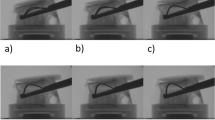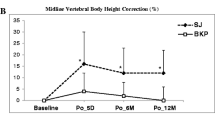Abstract
Objective
To compare radiologically balloon kyphoplasty (BKP) and vertebral compression fracture (VCF) expansion and corroborate with a finite element (FE) analysis. The principle of BKP is to stabilize VCF by restoring vertebral body anatomy using bone expansion and cement filling. More recently, vertebral body stenting (VBS) has been developed to reduce the loss of vertebral height observed after balloon deflation.
Methods
A retrospective, monocentric and continuous study of 60 non-osteoporotic fractures of the thoracolumbar junction treated by vertebral bone expansion was carried out over three years. The main endpoint was radiological correction of vertebral kyphosis (VK) at 3 months. The other studied parameters were vertebral height, index of Farcy, index of Beck, cement leakages and their location.
A FE model was developed to analyze effects linked to the stent during cement injection, specifically throughout the risk of cement leakage evaluation.
Results
After three months, average reduction of VK was 4.73° ± 4.8° after BKP, and 4.63° ± 2.7° after VBS. There was no difference between the two techniques, but cement leakage was significantly greater with BKP (41.7%) than with VBS (4.2%). FE analysis showed substantial changes of the cement flow orientation in the presence of a stent.
Conclusion
BKP and VBS offer comparable expansion with no added value of VBS in non-osteoporotic VCF reduction. VBS technique appears to prevent cement leakage due to its mesh architecture hindering the leaking process. In counterpart, such balloon expansion is likely to require higher pressure to deploy the stent. This could be an important parameter to take into account in young patients with high bone density.




Similar content being viewed by others
References
Kraemer WJ, Schemitsch EH, Lever J et al (1996) Functional outcome of thoracolumbar burst fractures without neurological deficit. J Orthop Trauma 10:541–544
Oppenheimer JH, DeCastro I, McDonnell DE (2009) Minimally invasive spine technology and minimally invasive spine surgery: a historical review. Neurosurg Focus 27:E9
Freslon M, Bouaka D, Coipeau P et al (2008) Thoracolumbar fractures. Rev Chir Orthop Reparatrice Appar Mot 94:S22–35
Oner FC, Dhert WJ, Verlaan J-J (2005) Less invasive anterior column reconstruction in thoracolumbar fractures. Injury 36:S82–S89
Bornemann R, Koch EMW, Wollny M, Pflugmacher R (2014) Treatment options for vertebral fractures an overview of different philosophies and techniques for vertebral augmentation. Eur J Orthop Surg Traumatol 24:131–143
Teyssédou S, Saget M, Prébet R et al (2012) Evaluation of percutaneous surgery in the treatment of thoracolumbar fractures. Preliminary results of a prospective study on 65 patients. Orthop Traumatol Surg Res 98:39–47
Rotter R, Martin H, Fuerderer S et al (2010) Vertebral body stenting: a new method for vertebral augmentation versus kyphoplasty. Eur Spine J Off Publ Eur Spine Soc Eur Spinal Deform Soc Eur Sect Cerv Spine Res Soc 19:916–923. https://doi.org/10.1007/s00586-010-1341-x
Bou-Francis A, Soyka RPW, Ferguson SJ et al (2015) Novel methodology for assessing biomaterial–biofluid interaction in cancellous bone. J Mech Behav Biomed Mater 46:158–167
Tsouknidas A, Savvakis S, Asaniotis Y et al (2013) The effect of kyphoplasty parameters on the dynamic load transfer within the lumbar spine considering the response of a bio-realistic spine segment. Clin Biomech 28:949–955
Fritzell P, Ohlin A, Borgström F (2011) Cost-effectiveness of balloon kyphoplasty versus standard medical treatment in patients with osteoporotic vertebral compression fracture: a Swedish multicenter randomized controlled trial with 2-year follow-up. Spine 36:2243–2251
Hartmann F, Griese M, Dietz S-O et al (2015) Two-year results of vertebral body stenting for the treatment of traumatic incomplete burst fractures. Minim Invasive Ther Allied Technol MITAT Off J Soc Minim Invasive Ther 24:161–166. https://doi.org/10.3109/13645706.2014.962546
Werner CML, Osterhoff G, Schlickeiser J et al (2013) Vertebral body stenting versus kyphoplasty for the treatment of osteoporotic vertebral compression fractures: a randomized trial. J Bone Jt Surg Am 95:577–584. https://doi.org/10.2106/JBJS.L.00024
Teyssédou S, Saget M, Gayet LE et al (2016) Radiologic study of disc behavior following compression fracture of the thoracolumbar hinge managed by kyphoplasty: a 52-case series. Orthop Traumatol Surg Res 102:61–65
Maestretti G, Cremer C, Otten P, Jakob RP (2007) Prospective study of standalone balloon kyphoplasty with calcium phosphate cement augmentation in traumatic fractures. Eur Spine J 16:601–610
Genant HK, Wu CY, Van Kuijk C, Nevitt MC (1993) Vertebral fracture assessment using a semiquantitative technique. J Bone Miner Res 8:1137–1148
Benneker LM, Heini PF, Anderson SE et al (2005) Correlation of radiographic and MRI parameters to morphological and biochemical assessment of intervertebral disc degeneration. Eur Spine J 14:27–35
Jarman JP, Arpinar VE, Baruah D et al (2015) Intervertebral disc height loss demonstrates the threshold of major pathological changes during degeneration. Eur Spine J 24:1944–1950
Magerl F, Aebi M, Gertzbein SD et al (1994) A comprehensive classification of thoracic and lumbar injuries. Eur Spine J Off Publ Eur Spine Soc Eur Spinal Deform Soc Eur Sect Cerv Spine Res Soc 3:184–201
McCormack T, Karaikovic E, Gaines RW (1994) The load sharing classification of spine fractures. Spine 19:1741–1744
Ulmar B, Brunner A, Gühring M et al (2010) Inter-and intraobserver reliability of the vertebral, local and segmental kyphosis in 120 traumatic lumbar and thoracic burst fractures: evaluation in lateral X-rays and sagittal computed tomographies. Eur Spine J 19:558–566
Alizadeh M, Kadir MRA, Fadhli MM et al (2013) The use of X-shaped cross-link in posterior spinal constructs improves stability in thoracolumbar burst fracture: A finite element analysis. J Orthop Res 31:1447–1454
Baroud G, Crookshank M, Bohner M (2006) High-viscosity cement significantly enhances uniformity of cement filling in vertebroplasty: an experimental model and study on cement leakage. Spine 31:2562–2568
Aubert K, Vendeuvre T, Lanel A, et al (2018) Kyphoplasty vs Stentoplasty: FE analysis of the risk of cement leakage. 8th World Congress of Biomechanics, Dublin, Ireland.
Yeom JS, Kim WJ, Choy WS et al (2003) Leakage of cement in percutaneous transpedicular vertebroplasty for painful osteoporotic compression fractures. J Bone Joint Surg Br 85:83–89
Voggenreiter G (2005) Balloon kyphoplasty is effective in deformity correction of osteoporotic vertebral compression fractures. Spine 30:2806–2812
Berlemann U, Franz T, Orler R, Heini PF (2004) Kyphoplasty for treatment of osteoporotic vertebral fractures: a prospective non-randomized study. Eur Spine J 13:496–501
Klezl Z, Majeed H, Bommireddy R, John J (2011) Early results after vertebral body stenting for fractures of the anterior column of the thoracolumbar spine. Injury 42:1038–1042. https://doi.org/10.1016/j.injury.2011.04.006
Sato K, Kikuchi S, Yonezawa T (1999) In vivo intradiscal pressure measurement in healthy individuals and in patients with ongoing back problems. Spine 24:2468
Majd ME, Farley S, Holt RT (2005) Preliminary outcomes and efficacy of the first 360 consecutive kyphoplasties for the treatment of painful osteoporotic vertebral compression fractures. Spine J 5:244–255
Garnier L, Tonetti J, Bodin A et al (2012) Kyphoplasty versus vertebroplasty in osteoporotic thoracolumbar spine fractures. Short-term retrospective review of a multicentre cohort of 127 consecutive patients. Orthop Traumatol Surg Res 98:S112–S119. https://doi.org/10.1016/j.otsr.2012.03.018
Acknowledgements
The authors wish to thank Jeffrey Arsham, an American translator, for rereading and correction of the original English-language manuscript.
Funding
No funding was received for this study.
Author information
Authors and Affiliations
Corresponding author
Ethics declarations
Conflict of interest
T. Vendeuvre is consultant for companies Medtronic (Dublin, Ireland), Safe Orthopaedics (Paris, France), Spineart (Geneva, Switzerland), and he has received previously research grants from company Medtronic for other research works. P. Rigoard is consultant for companies Medtronic (Dublin, Ireland), Boston Scientific (Malborough, MA, USA), ABBOTT (Chicago, IL, U.S.), and he has received previously research grants from company Medtronic for other research works. P. Pries is consultant for company Spineart (Geneva, Switzerland). S. Teyssédou is consultant for companies Medtronic (Dublin, Ireland) and Safe Orthopaedics (Paris, France). A. Germaneau is consultant for company Medtronic (Dublin, Ireland).
Additional information
Publisher's Note
Springer Nature remains neutral with regard to jurisdictional claims in published maps and institutional affiliations.
Rights and permissions
About this article
Cite this article
Vendeuvre, T., Brossard, P., Pic, JB. et al. Vertebral balloon kyphoplasty versus vertebral body stenting in non-osteoporotic vertebral compression fractures at the thoracolumbar junction: a comparative radiological study and finite element analysis (BONEXP study). Eur Spine J 30, 3089–3098 (2021). https://doi.org/10.1007/s00586-021-06785-5
Received:
Revised:
Accepted:
Published:
Issue Date:
DOI: https://doi.org/10.1007/s00586-021-06785-5




